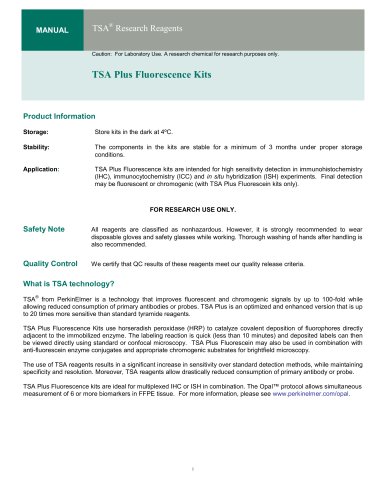
Catalog excerpts

TECHNICAL BRIEF | Opal Storage and Stability Opal Storage and Stability LYO PHILIZE D Lyophilized Opal fluorophores (Opals) are extremely stable long-term when stored in the dark at -20°C. Performance should not be impacted if lyophilized Opal fluorophores have been exposed to room temperature (RT), if exposure was less than seven days. RECON STIT UT E D Reconstitute all Opals (except Opal Polaris 780) with 75ul Dimethylsulfoxide (DMSO). Reconstitute Opal Polaris 780 with 300uL double distilled water (ddH2O). Reconstituted Opals should be stored at 4°C in the dark. We guarantee performance three months post-reconstitution when stored as directed. DILU TED TO WOR KING SOLUT I ON Reconstituted Opals should be diluted in 1X Plus Amplification Diluent (or 1X Plus Automation Amplification Diluent if staining on automated platform) except for Opal Polaris 780 which is diluted with Opal Antibody Diluent/ Block. Opal working solution is good for 24-48 hours, regardless of storage conditions. Working solution should be prepared for the volume needed, including automatic staining dead volume. Minimize exposure to light. DO NOT FREEZE working solution. Discard unused working solution. O PAL RECO N ST IT UT ION BEFORE RE CONST IT UT ION • Bring lyophilized Opal fluorophore and DMSO or ddH2O to RT and ensure that DMSO is completely liquid before reconstitution. ݸDMSO freezes at 4°C. Ensure DMSO is free of crystals. • Centrifuge lyophilizate for 10 seconds at 10 x g at RT. • Dissolve lyophilizate in DMSO by gently vortexing. A FTER RE CONST IT UT ION • Centrifuge stock solution for 10 seconds at 10 x g at RT. • Let Opal fluorophore stock stand 10-15 minutes at RT to ensure lyophilizate has completely dissolved. • Vortex and centrifuge Opal fluorophore stock again for 10 seconds at 10 x g at RT. • Prepare working aliquots of 5 - 10 ul each depending on desired use and wrap aliquot caps with parafilm. ݸDMSO is extremely hydroscopic and water could cause the dye to hydrolyze. • Store in the dark at 4°C. ݸUse non-transparent caps OR wrap aliquots in aluminum foil. • For subsequent preparation of working solution please ensure reconstituted Opals are completely dissolved before pipetting. ݸHold in your hand and flick the tube a few times before gently vortexing. ݸImportant: Centrifuge solution at 10 s at 10 x g at RT. ݸOpen the cap and pipette the minimal amount required for a working solution. • Minimize the number of freeze/thaw cycles by aliquoting reconstituted Opal fluorophore stock solution into microcentrifuge vials. FOR RESEARCH USE ONLY. NOT FOR USE IN DIAGNOSTIC PROCEDURES. © 021 Akoya Biosciences, Inc. All rights reserved. Akoya Biosciences and The Spatial Biology Company 2 are registered trademarks of Akoya Biosciences, Inc
Open the catalog to page 1
TECHNICAL BRIEF | Opal Storage and Stability To learn more visit A K O Y A B I O . C O M or email us at I N F O @ A K O Y A B I O . C O M © 2020 Akoya Biosciences, Inc. All rights reserved. Akoya Biosciences and Codex are registered trademarks of Akoya Biosciences, Inc. A Delaware corporation. DN-00069
Open the catalog to page 2All Akoya Biosciences catalogs and technical brochures
-
Anti-Hu Ki67
2 Pages
-
TSA® Research Reagents
12 Pages





